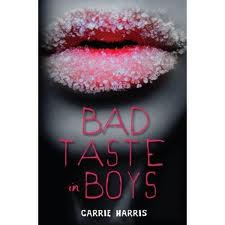Debut Novel: Spreadsheets Used for Plotting and Revising a Novel
Introduced first in 2007, debut children’s authors have formed a cooperative effort to market their books. I featured Revision Stories from the Classes of 2k8 and 2k9 and this feature returns this year with the Class of 2k11.
An 8-Revision Success Story: Thanks, Spreadsheets!
Guest post by Carrie Harris
I feel like there should be a support group for that, don’t you? Because we’ve all heard about the authors who change four words in their first draft, slap a cover on it, and BAM! Instant bestseller. I think those people are mutants. Or aliens. Or mutant aliens.
Not me, though. My book, BAD TASTE IN BOYS, went through about seven large scale revisions before my agent sent it out. And then my editor had me rewrite about 2/3 of it. From SCRATCH.
Scary? Maybe a little. But it wasn’t all that bad because I found a revision process that made me comfortable. Everyone’s got an opinion on how to revise, right? You NEED note cards. You NEED a corkboard. You NEED an outline. You NEED to print your manuscript and read it aloud in Pig Latin.
And sure, try all those things, except maybe the Pig Latin. But don’t do what I did—don’t stick with a system that doesn’t work for you. For years, I used a corkboard to plot my books, because everyone knows that writers use corkboards, right? There was just one problem—I hated that corkboard with the fire of a thousand suns.
It didn’t work for me, either. So when those massive revisions came from my editor, I pulled it off the wall, stomped on it therapeutically for a while, and opened up an Excel spreadsheet. That’s right; I use Excel for revisions. I don’t know anyone else who does it that way. But it works for me.
(NOTE from Darcy: For more on spreadsheet plotting see this post on spreadsheet plotting and this one comparing the advantages of spreadsheet plotting and the shrunken manuscript.)
Now I create spreadsheets for all my books. I list the major elements in each scene: plot points, characters, setting, time of day. I also keep track of my personal tics. For example, my first drafts always have too much driving or walking from one place to another, so I have a column for that. And when I’m done, I’ve got a clear view of the whole manuscript…and the glaring problems. It doesn’t work to stick your MC in the same room for 75 pages at a pop, but somehow I can’t see that when I’m reading. Once that spreadsheet is done? I usually smack myself in the forehead, because DUH! Why didn’t I notice it before?
Once I understand the problems, fixing them is relatively easy. Sure, revision is still a massive undertaking, but my spreadsheets give me a framework instead of just this big disjointed stack of scenes that I’ve got to somehow solidify into a book.
Find Your Revision Strategy
Does this mean you MUST use Excel to revise your next manny? Try it if it sounds appealing, but that’s not my point! My point is that if you are a revision-hater, the problem isn’t YOU. The problem is that you haven’t found YOUR process yet. There are a million ways to revise. Don’t stop until you’ve found yours, even if it’s something wonky and off-the-wall. If it works, who cares?
And if your process involves Pig Latin, I want to talk to you. I’ve got to know how you do it.
If you can’t see the book trailer, you can see it on YouTube here.

Ooh, thanks for sharing, Carrie! I love hearing about others’ writing processes. The spreadsheet is a great idea, I’ll give it a shot and see if it works for me!